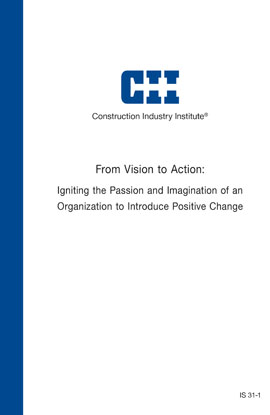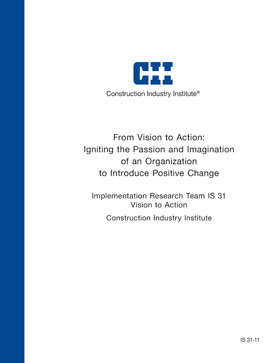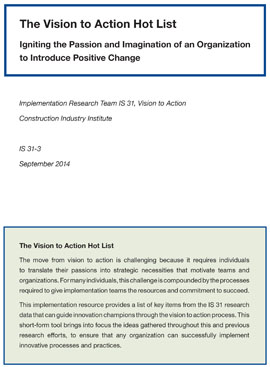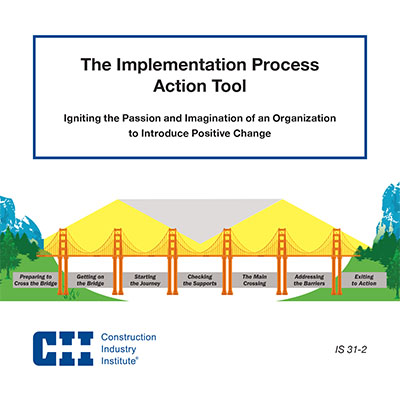
From Vision to Action: Igniting the Passion and Imagination of an Organization to Introduce Positive
Continuous improvement is the essential component of long-term success. Whether viewed as innovation, progress, or competitive edge, the introduction of new ideas creates a sustainable advantage for engineering, procurement, and construction (EPC) organizations. However, to achieve success, organizations must recognize that introducing new ideas requires the stimulation of interest and curiosity within the organization. Maintaining this motivation throughout the process of implementing such innovations is critical to propelling continuous improvement. The continuing challenge for organizations is to inspire, foster, and expand the passion for innovation and new practices throughout this process.
Having conducted a literature search, survey, structured interviews, and a series of case studies, CII IS 31, Vision to Action Implementation Research Team found empirical evidence of a gap between the initial step of establishing a vision for new practices and the overall implementation process. These findings culminated in the development of two implementation resources: 1) Implementation Strategy (IS) 31-2, The Implementation Process Action Tool: Igniting the Passion and Imagination of an Organization to Introduce Positive Change, a guide that provides a qualitative and a quantitative foundation for moving from vision to action; and 2) IS 31-3, The Vision to Action Hot List, a laminated reference for motivating executive management to consider new ideas and then act on them.
The journey across the vision-to-action gap requires organizations to take the following distinct steps:
- Preparing to Cross – Focus on management buy-in and the development of the appropriate vision for implementation.
- Getting on the Bridge – Establish metrics and statements of necessity to ensure the organization’s understanding of why the implementation is needed and how it will be evaluated.
- Starting the Journey – Ensure that a team is in place to guide the implementation and to gather resources to support the implementation.
- Checking the Supports – Determine whether the appropriate cultural, managerial, and technical support is in place for a successful implementation.
- The Main Crossing – Ensure that the organization has a defined plan and roadmap for completing the implementation effort.
- Addressing the Barriers – Determine whether the implementation will encounter common barriers and if the team is prepared to address these barriers.
- Exiting to Action – Ensure that the organization can communicate what it has done, how it will build on this action, and why the new practice is important to the organization.
The first challenge for anyone seeking to improve existing paradigms within EPC organizations is to capture the imagination of executives, and the IS 31 team developed the short-form “Hot List” resource for this purpose. Once upper-level management has committed to the new practice or innovation, the champion should then use the IMPACT tool to assess commitment to implementation and continuous improvement. Ultimately, organizations must determine whether they are willing to put the resources and management support behind the continuous improvement opportunities presented by innovative ideas.



